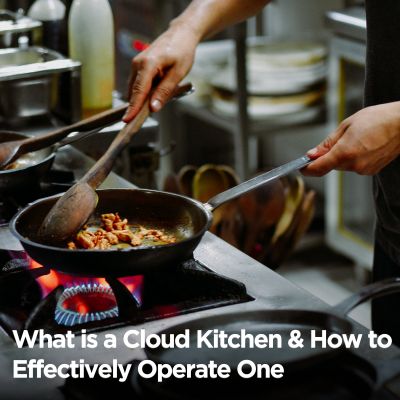Food delivery has become a daily habit for many people, especially in busy cities. This change in how meals are ordered and consumed has led to new ways of running food businesses. One model gaining real attention is the cloud kitchen.
Also known as a ghost or virtual kitchen, it’s a delivery-focused facility without a dining area or front-of-house service. Orders come in online, and the food is prepared in a central kitchen and then sent out for delivery.
So, what is a cloud kitchen in practical terms? It’s a streamlined operation that helps restaurants lower costs, reach more customers, and test new concepts without opening a full restaurant.
This guide will explain how cloud kitchens work and offer strategies for running one successfully. Whether starting from scratch or expanding an existing brand, knowing what’s involved can help you succeed in today’s delivery-driven food business.
What Is a Cloud Kitchen?
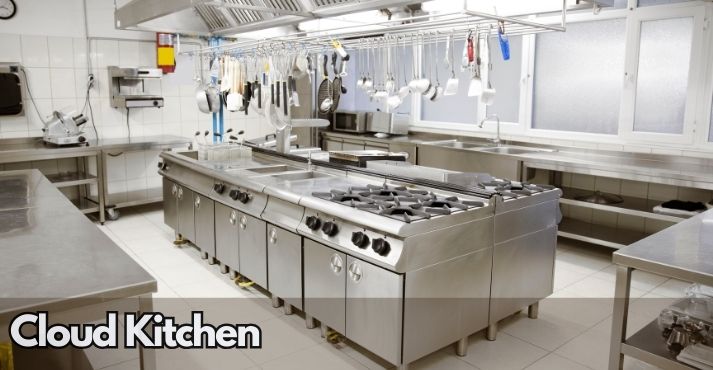
A cloud kitchen, sometimes called a ghost kitchen, dark kitchen, or delivery-only restaurant, is a professional food production space built specifically for delivery and takeout orders. Unlike traditional restaurants, it doesn’t offer dine-in services or a visible storefront.
Instead, it operates from a commercial kitchen and focuses entirely on online sales through Uber Eats, DoorDash, and Deliveroo.
The cloud kitchen business makes it easier for food entrepreneurs to reduce operating costs and test new concepts without a traditional restaurant setup. It also supports the rise of virtual brands operating exclusively online and catering to changing food delivery habits.
To put this into perspective, online food ordering has grown nearly 300% faster than dine-in services in recent years. With this demand, many food operators are exploring what the cloud kitchen means for their future strategy and how to build a delivery-first operation that works.
Key Differences Between Cloud Kitchens and Traditional Restaurants
In comparing a cloud kitchen vs. traditional restaurant, the operations differ significantly. Traditional restaurants need a physical space, dining area, and staff to provide the full dining experience.
Cloud kitchens operate from rented kitchen space, focusing on preparing food solely for delivery or takeout, which cuts costs tied to real estate, décor, and in-house staff.
Customer interaction is another difference. In traditional restaurants, guests engage with staff directly, but cloud kitchens rely on food ordering systems and delivery aggregators to manage incoming orders. There’s no need for face-to-face service, as the focus is on efficient order fulfillment.
Revenue models also vary. Traditional restaurants rely on customer visits, while cloud kitchens operate primarily through delivery orders, often running multiple brands from a single location.
To stay organized, POS systems are used to manage orders, and effective inventory management in restaurants is crucial to maintain stock levels and avoid waste.
Cloud Kitchen Business Models
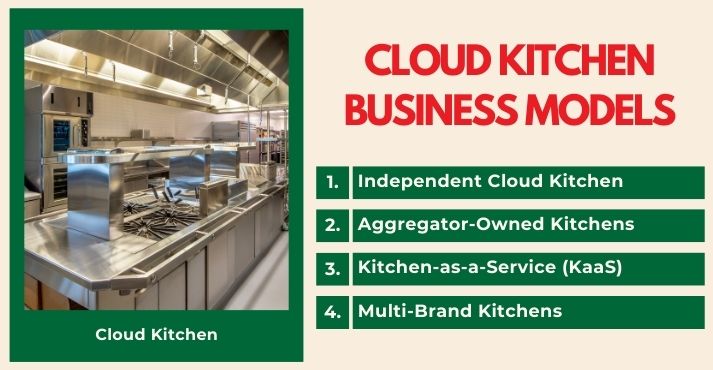
Cloud kitchens come in various models, each offering flexibility in setup, scale, and operations. Unlike a full-service restaurant, these setups are optimized for speed, efficiency, and reach. Let’s break down how cloud kitchens work in different formats:
1. Independent Cloud Kitchen
This model involves a single brand running its kitchen without a storefront. Operators rent a small commercial kitchen space, often in a shared kitchen, to prepare food exclusively for delivery.
- Pros: Full control over branding, menu, and pricing. It’s easier to experiment and pivot based on customer preferences.
- Cons: Handling logistics, delivery coordination, and digital marketing alone can be time-consuming and costly.
2. Aggregator-Owned Kitchens
Food delivery platforms like Uber Eats or DoorDash offer ready-to-use kitchens to partner brands. Businesses use these spaces to fulfill delivery orders under the aggregator’s umbrella.
- Pros: Easy market entry with access to established customer bases. Equipment and utilities are often provided.
- Cons: Limited control over customer data and brand visibility. These kitchens can also be dependent on aggregator fees and policies.
3. Kitchen-as-a-Service (KaaS)
This plug-and-play model allows businesses to rent operational kitchens with all the infrastructure. These setups help streamline launch timelines, especially for new brands testing new markets.
- Pros: No need to invest heavily in infrastructure or long-term leases. The KaaS model supports fast scaling and low commitment.
- Cons: Depending on the provider, restrictions may exist on layout customization or operating hours.
4. Multi-Brand Kitchens
In this setup, a single operator manages multiple virtual brands from one kitchen. It’s a smart way to cater to different food cravings without needing separate locations.
- Pros: Shared staff, equipment, and ingredients lower overall costs. A well-executed multi-brand strategy can significantly boost sales across demographics.
- Cons: Operational complexity increases with every new brand. Menu planning and order coordination require strong back-end systems.
Recent estimates put the global cloud kitchen market at over $58 billion in 2022. With delivery-first dining continuing to rise, it’s projected to surpass $175 billion by 2032, showing significant changes in how restaurants make and deliver food.
Benefits of Starting a Cloud Kitchen
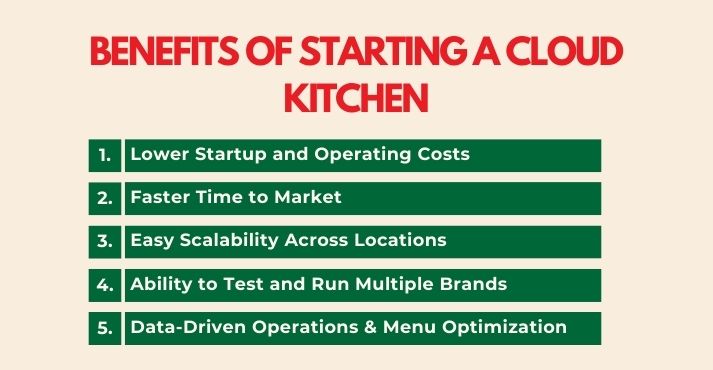
The benefits of cloud kitchens make them a smart option for restaurant owners and food entrepreneurs focused on delivery. Instead of spending on dine-in space or large teams, operators can run efficient kitchens built just for takeout and delivery.
This setup is a practical choice for new businesses starting small or established brands wanting to grow without high costs.
1. Lower Startup and Operating Costs
Cloud kitchens avoid the need for dining areas, servers, and décor, cutting down drastically on rent, utilities, and front-of-house staff. This makes it much cheaper to launch compared to a full-service restaurant.
The simplified kitchen layout is optimized for food prep and delivery, helping reduce operational complexity. Entrepreneurs benefit from substantial CAPEX savings, especially in expensive urban areas where real estate costs are a significant barrier.
2. Faster Time to Market
Cloud kitchen operators can launch their brands in weeks without the need to design a physical dining experience or secure prime foot traffic locations. Menu development, licensing, and equipment setup are faster when focused solely on delivery.
This gives operators a major advantage when responding to food trends, seasonal offerings, or testing new business ideas quickly and affordably.
3. Easy Scalability Across Locations
With a cloud kitchen model, growth isn’t limited by front-of-house capacity or traditional real estate concerns. Operators can replicate their setup in new regions using a shared kitchen or leased prep space.
Expansion becomes more about digital reach and logistical efficiency than expensive storefronts, making it easier to scale across cities or countries with minimal capital.
4. Ability to Test and Run Multiple Brands
One of the most significant advantages is launching and managing several virtual brands from a single location. Operators can test different cuisines, pricing strategies, or branding concepts, all within the same kitchen.
This brand testing flexibility allows them to fine-tune what works without committing to full restaurant concepts, helping reduce risk while maximizing kitchen output.
5. Data-Driven Operations and Menu Optimization
Cloud kitchens are highly digital, allowing for real-time tracking of order data, prep times, delivery performance, and customer feedback.
With this insight, operators can fine-tune their offerings through online menu optimization, removing slow movers, adjusting portion sizes, or updating ingredients to suit demand. This helps ensure kitchens run more efficiently and stay aligned with customer preferences.
Nearly 63% of consumers now prefer ordering food online over dining out. Cloud kitchens make it easier for food businesses to reach customers through delivery apps and mobile orders.
Challenges to Expect When Running a Cloud Kitchen
Running a cloud kitchen may cut costs and speed up setup, but it also comes with challenges that operators must manage carefully. Since these kitchens rely entirely on delivery, food delivery delays are major issues.
When food doesn’t arrive hot or on time, it affects customer satisfaction, even if the kitchen itself did everything right. Working with third-party delivery services adds a layer of complexity that’s sometimes outside your control.
Another common challenge is the lack of brand visibility. Without a physical store or foot traffic, it’s harder for new brands to stand out. This makes digital marketing and app positioning more important and more competitive.
Building customer trust also takes extra effort, primarily when customers can’t interact with staff or see where their food is made. High food quality, strong packaging, and consistent service are essential for keeping customers returning in a delivery-only setup.
How to Effectively Operate a Cloud Kitchen
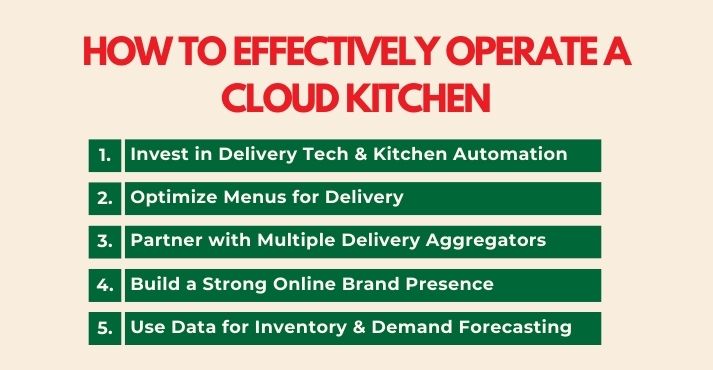
Running a cloud kitchen effectively requires more than just preparing quality food. Success comes from streamlining operations, optimizing menus, using delivery platforms, building a strong online presence, and making data-driven decisions.
By focusing on these areas, operators can avoid common mistakes and enhance their delivery-only business model.
1. Invest in Delivery Tech and Kitchen Automation
Managing delivery orders efficiently is critical. Integrated order tracking tools allow teams to handle multiple orders across platforms without missing a beat.
Adding kitchen automation systems like smart appliances and digital displays helps maintain consistency, especially when order volume spikes. These systems reduce errors and improve prep speed without adding more staff.
2. Optimize Menus for Delivery
Keep your menu focused on dishes that travel well and are easy to prepare quickly. Good food packaging design helps retain heat and prevent leaks, which keeps food appealing when it arrives.
Through online menu optimization, businesses can adjust offerings based on sales data, removing slow sellers and highlighting popular, high-margin items.
3. Partner with Multiple Delivery Aggregators
Signing up with several delivery aggregator apps gives you a wider reach. Before choosing partners, compare fees, delivery areas, and platform support. Expanding through multi-channel sales avoids over-reliance on one source and helps tap into different customer bases.
4. Build a Strong Online Brand Presence
Your brand should be recognizable wherever people find you — on apps, your website, or social media. A solid digital brand marketing strategy includes local influencer promotions and search visibility.
Improving local food SEO ensures your business appears in neighborhood searches, while showcasing customer reviews builds trust with new users.
5. Use Data for Inventory and Demand Forecasting
Linking your POS with inventory management software allows you to track usage and avoid overstocking or waste.
With help from demand prediction tools, operators can better anticipate peak times and reorder smartly. This leads to tighter cost control and smoother day-to-day operations.
Legal and Regulatory Considerations
Before launching a cloud kitchen, ensuring everything is compliant from day one is essential. Operating in this space means meeting local health, safety, and business standards — rules often differ by city or province.
Start with the basics: securing a business registration and checking zoning laws to confirm that commercial cooking is allowed in your chosen area. Even though there’s no dine-in service, your space must meet food safety standards like any traditional kitchen.
Operators are usually required to obtain a food handler license for anyone preparing meals. You may also need a cloud kitchen license in some regions, depending on how your facility is structured and whether it’s shared with others.
Don’t overlook insurance. From general liability to equipment coverage, having the right policies protects you from unexpected disruptions. Local requirements can vary, so it’s smart to consult legal or regulatory experts familiar with food service operations in your province or city.
Marketing Your Cloud Kitchen for Success
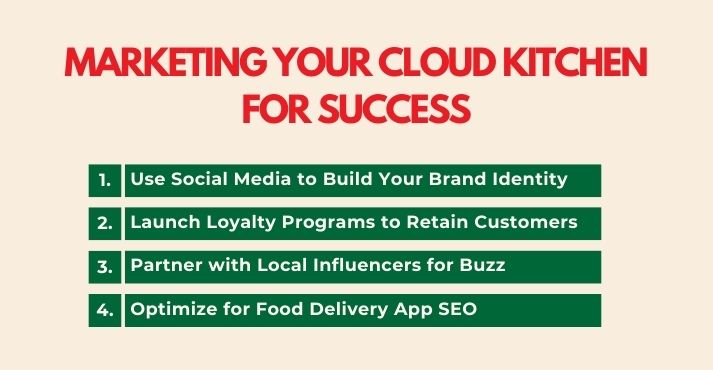
Strong marketing is important for standing out in a competitive delivery-first market. Without a physical store, your brand relies entirely on digital visibility and reputation. The right strategies improve discovery, increase orders, and build long-term customer connections.
1. Use Social Media to Build Your Brand Identity
Platforms like Instagram, TikTok, and Facebook are ideal for showcasing your food and team. Behind-the-scenes videos and vibrant food photos help give your brand a relatable personality.
Posting consistently and running geo-targeted promotions can help you reach local audiences most likely to order. Effective cloud kitchen branding combined with social media food marketing can quickly build recognition and trust online.
2. Launch Loyalty Programs to Retain Customers
Rewarding repeat customers builds stickiness. Simple digital punch cards or app-based point systems give customers a reason to return. Offering a free item or discount after a few orders can strengthen that connection.
Online loyalty programs and integrated customer retention tools within your website or delivery app make rewards easy to manage and appealing to users.
3. Partner with Local Influencers for Buzz
Influencers focusing on your area can introduce your food to highly engaged local audiences. Collaborate with food bloggers or micro-influencers by offering tastings or sharing promo codes.
What matters most is finding creators with strong engagement rather than just large followings. Influencer food marketing through local food influencers helps build awareness and encourages customers to try your offerings quickly.
4. Optimize for Food Delivery App SEO
Make your restaurant listing easy to find and appealing to browse. Use keywords in your name and dish descriptions to improve visibility within delivery apps. Add sharp images, highlight positive reviews, and update your menu and hours.
These steps enhance food delivery listing optimization and boost food app visibility. Reviews are compelling, with 94% of consumers checking feedback on platforms like Yelp and TripAdvisor before placing an order.
Using focused restaurant marketing strategies helps your cloud kitchen attract new customers and keep them coming back for more.
Conclusion
Cloud kitchens offer a focused and efficient way for food businesses to meet rising delivery demand. They reduce startup and operating expenses without the need for dine-in space while helping brands enter the market faster.
Entrepreneurs can test multiple concepts from one location, adjust menus based on customer preferences, and serve more areas through delivery platforms.
Compared to traditional full-service restaurants, this model makes it easier to respond to changing consumer habits and streamline daily operations.
That said, long-term success requires more than just setting up a kitchen. It’s important to invest in the right technology, maintain food consistency, and build an online presence that customers trust.
With strong planning, attention to detail, and a focus on customer satisfaction, cloud kitchens can become reliable for launching and growing food brands in today’s delivery-first market.

